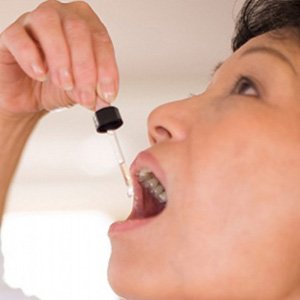Allergy Drops
Allergy Drops – Sublingual Immunotherapy
Allergy drops are self-administered treatment placed once daily under the tongue. The drops are placed under the tongue where antigen-presenting cells are highly concentrated. The dosage is gradually increased over time until the patient no longer experiences a reaction to the allergen.
 At last, no needles….
At last, no needles….
Allergy immunotherapy without needle injections is called Sublingual Immunotherapy or Allergy Drops. In recent years, sublingual immunotherapy has gained popularity in the treatment of allergies. This treatment is widely utilized in Europe and the World Health Organization has endorsed sublingual immunotherapy as a viable alternative to allergy injection immunotherapy. Many of our patients, both adults and children, receive the same significant benefit with allergy immunotherapy using allergy drops. There have been numerous medical studies on sublingual immunotherapy and this treatment is now a “headliner” at major allergy conferences. In the upcoming years, we expect allergy drops to become a standard in the treatment of many allergic conditions, including hay fever, asthma, eczema, and possibly food allergies. Studies are already underway for using allergy drops for prevention of peanut allergy.
What is Sublingual Immunotherapy or Allergy Drops?
In sublingual immunotherapy, the route of exposing and desensitizing the body to allergens is accomplished through placing allergy drops underneath the tongue. Patient-specific allergy drop solution is formulated based on each individual person’s skin testing results. The solution is the same allergy extract that is FDA-approved for allergy shots.
Once testing is complete, solution is made, and patients are ready to begin this program, we ask patients to return to our office for their initial allergy drop session. Here we review the details, timing, and methods for proper allergy drop administration. Patients are watched for 30-minutes and if no reactions occur, can then take their allergy drops with them to have future drops placed at home.
A build-up phase occurs over the first three months where anywhere from one to three drops from each vial are administered underneath the tongue. After three months, a maintenance-phase is reached where patients simply apply three drops from each of their allergy vials underneath their tongue once daily. A major advantage of allergy drops is that it is administered in the convenience of your home, instead of at the doctor’s office. No wait times!
How Effective are Allergy Drops?
Although allergy shots are considered the “gold standard” for allergy treatment in the United States, allergy drops are considered first line treatment in a number of European countries. They are very effective in relieving allergy and asthma symptoms, making them worth considering as an alternative to allergy injections for many patients, particularly children. As with allergy injections, numerous medical studies have proven that allergy drops can help prevent the onset of asthma in children with allergic rhinitis (hay fever). There have also been many studies showing that allergy drops have resulted in a significant reduction in the need for allergy and asthma medications.
Are the Allergy Drops Safe?
The incidence of significant adverse reactions to allergy drops is very low and the most common reaction reported is mild itching or tingling of the mouth or tongue. It is extremely rare to have a serious systemic reaction to allergy drops, even more rare than with allergy shots. With dosing adjustments, treatment usually proceeds as scheduled, without further incident. As noted above, the extracts used in sublingual immunotherapy are the same FDA-approved, standardized extracts used in injection immunotherapy.
However, because the FDA has not yet approved these allergy extracts for sublingual administration, they are classified as “off-label”. Off-label use of an FDA-approved product is extremely common in the United States, and is often utilized by physicians. The classic example is the off-label use of aspirin to help prevent heart attacks, which occurred for years when the FDA had not yet approved this use, even though it was widely known that aspirin treatment was safe and effective. Other examples include the use of seizure medications which were proven and widely used off-label to prevent migraine headaches and chemotherapy agents, approved by the FDA to treat one form of cancer, which were then proven to be very effective and commonly used to treat other forms of cancer. There is frequently a very long lag time between when a medical treatment is proven to be effective and when the FDA approves it to treat a specific medical condition.
Given allergy drops are not FDA-approved, insurances do not cover the cost of allergy drops. There are inherent costs to purchasing allergy extract and formulating it appropriately that are built into the cost of allergy drops. We offer competitive pricing. If you have a high-deductible insurance plan, you may find that allergy drops are a more affordable option than injection therapy.
How do I Start this Treatment for Me or My Child?
The first step is to identify your underlying allergies with skin testing or blood work testing. From there, we will formulate your drops based on the results of your allergy testing and medical evaluation. The allergy drops are individualized to treat your allergies and will contain the allergens only to which you are allergic.
See these links for more detailed information on sublingual immunotherapy
· American Academy of Allergy Asthma & Immunology
· Adult & Pediatric Clinical Trials of Sublingual Immunotherapy
· Efficacy of Sublingual Immunotherapy versus Subcutaneous Injection Immunotherapy in Allergic Patients
· Quality of Life Improvement with Sublingual Immunotherapy: A Prospective Study of Efficacy
· Preventive effects of sublingual immunotherapy in childhood: an open randomized controlled study
· Allergen-Specific Immunotherapy for Pediatric Asthma and Rhinoconjunctivitis: A Systematic Review
